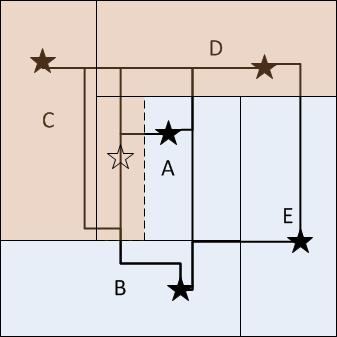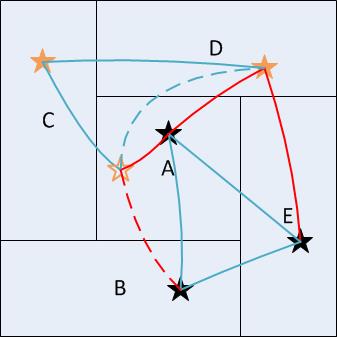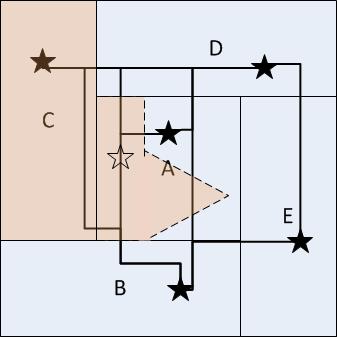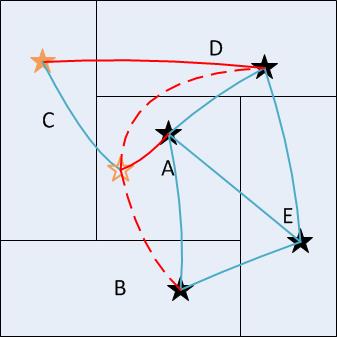Fragment
A fragment is a contiguous geographic unit created by a chop of a larger whole geographic unit. A fragment is like other geographic units that are determined by fixed political boundaries in that fragments have all the same data and can be built from individual census blocks. However, fragments are artifacts of a specific redistricting plan and have no special legal status other than to facilitate mapping.
Like all other geographic units a fragment has a node and links. A fragment that contains the node of the whole geographic unit has that same node as the node of the whole unit. A fragment that does not contain the node of the whole geographic unit has as its node the node of the subunit in the fragment with the largest population.
Connections for fragments follow from the connections that exist in the whole geographic unit. Paths used as connections that enter the whole unit within a fragment are links to the node of that fragment. There is a link between two fragments in the same whole unit if the fragments are locally connected.
Example 1
The shaded area represents a district that chops unit A.
The fragment of A on the right has a node from the original whole unit A. The fragment on the left has a node created at the node largest population subunit - shown as a hollow star.
The path from A to C without a chop enters A in the left side fragment, so there is a link from the left side fragment to C.
The path from A to E without a chop enters A in the right side fragment, so there is a link from the right side fragment to E.
The primary path from A to D without a chop enters A in the right side fragment, so there is a link from the right side fragment to D. A secondary path from A to D enters A in the left side fragment, but does not form a link.
The primary path from A to B without a chop enters A in the right side fragment, so there is a link from the right side fragment to B. A secondary path from A to B enters A in the left side fragment, but does not form a link.
There is a path between the fragments that forms a local connection, so there is a link between the two fragments of A.
The equivalent graph colors the nodes of the two districts in different colors. The dashed links represent secondary paths to the nodes that do not count as links. The red links indicate connections and secondary paths that link nodes in different districts.
Example 2
The shaded area represents a district that chops unit A.
The fragment of A on the right has a node from the original whole unit A. The fragment on the left has a node created at the node largest population subunit - shown as a hollow star.
The path from A to C without a chop enters A in the left side fragment, so there is a link from the left side fragment to C.
The path from A to E without a chop enters A in the right side fragment, so there is a link from the right side fragment to E. The path passes through the left side fragment, but because it is a fragment only the entry point matters and that is on the right side.
The primary path from A to D without a chop enters A in the right side fragment, so there is a link from the right side fragment to D. A secondary path from A to D enters A in the left side fragment, but does not form a link.
The primary path from A to B without a chop enters A in the right side fragment, so there is a link from the right side fragment to B. A secondary path from A to B enters A in the left side fragment, but does not form a link. The path passes through the left side fragment, but because it is a fragment only the entry point matters and that is on the right side.
There is a path between the fragments that forms a local connection, so there is a link between the two fragments of A.
The equivalent graph colors the nodes of the two districts in different colors. The dashed links represent secondary paths to the nodes that do not count as links. The red links indicate connections and secondary paths that link nodes in different districts.
Isolated Fragments
Some fragments may have no connections based on the connections of the whole unit. These are isolated fragments. For isolated fragments links are created to each adjacent unit that is locally connected to the fragment node.




